https://github.com/jayknoxqu/rmi-example
分布式通讯(rmi) remote method invocation example(java、scala、kotlin、springboot、zookeeper)
https://github.com/jayknoxqu/rmi-example
kotlin rmi scala springboot2 zookeeper
Last synced: 5 months ago
JSON representation
分布式通讯(rmi) remote method invocation example(java、scala、kotlin、springboot、zookeeper)
- Host: GitHub
- URL: https://github.com/jayknoxqu/rmi-example
- Owner: jayknoxqu
- Created: 2018-07-11T17:12:31.000Z (over 7 years ago)
- Default Branch: master
- Last Pushed: 2023-10-11T20:58:20.000Z (about 2 years ago)
- Last Synced: 2024-08-08T21:18:26.959Z (over 1 year ago)
- Topics: kotlin, rmi, scala, springboot2, zookeeper
- Language: Kotlin
- Homepage:
- Size: 146 KB
- Stars: 48
- Watchers: 2
- Forks: 29
- Open Issues: 1
-
Metadata Files:
- Readme: README.md
Awesome Lists containing this project
README
### RMI简介
**Java RMI**,即 **远程方法调用**([Remote Method Invocation](https://en.wikipedia.org/wiki/Distributed_object_communication)),一种用于实现**远程过程调用**(RPC)[(Remote procedure call)](https://en.wikipedia.org/wiki/Remote_procedure_call)的Java API, 能直接传输序列化后的Java对象和[分布式垃圾收集](https://en.wikipedia.org/wiki/Distributed_Garbage_Collection)。它的实现依赖于[Java虚拟机](https://en.wikipedia.org/wiki/Java_Virtual_Machine)(JVM),因此它仅支持从一个JVM到另一个JVM的调用。
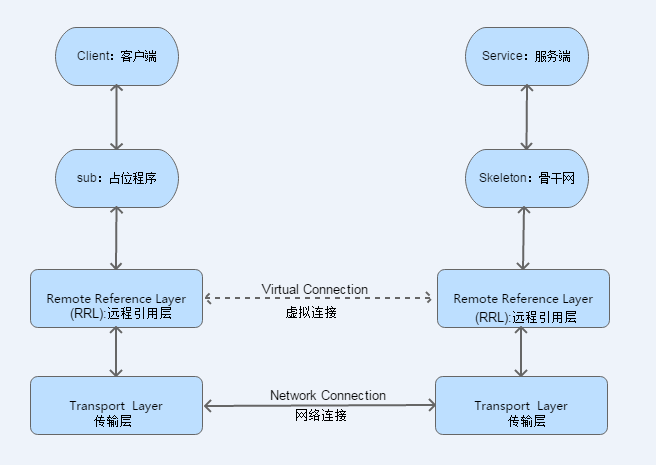
### rmi的实现
#### (1) 直接使用Registry实现rmi
##### 服务端:
```java
public class RegistryService {
public static void main(String[] args) {
try {
// 本地主机上的远程对象注册表Registry的实例,默认端口1099
Registry registry = LocateRegistry.createRegistry(1099);
// 创建一个远程对象
HelloRegistryFacade hello = new HelloRegistryFacadeImpl();
// 把远程对象注册到RMI注册服务器上,并命名为HelloRegistry
registry.rebind("HelloRegistry", hello);
System.out.println("======= 启动RMI服务成功! =======");
} catch (RemoteException e) {
e.printStackTrace();
}
}
}
```
##### 接口:
继承Remote接口
```
public interface HelloRegistryFacade extends Remote {
String helloWorld(String name) throws RemoteException;
}
```
##### 接口实现:
继承UnicastRemoteObject
```
public class HelloRegistryFacadeImpl extends UnicastRemoteObject implements HelloRegistryFacade{
public HelloRegistryFacadeImpl() throws RemoteException {
super();
}
@Override
public String helloWorld(String name) {
return "[Registry] 你好! " + name;
}
}
```
##### 客户端:
```java
public class RegistryClient {
public static void main(String[] args) {
try {
Registry registry = LocateRegistry.getRegistry(1099);
HelloRegistryFacade hello = (HelloRegistryFacade) registry.lookup("HelloRegistry");
String response = hello.helloWorld("ZhenJin");
System.out.println("=======> " + response + " <=======");
} catch (NotBoundException | RemoteException e) {
e.printStackTrace();
}
}
}
```
##### 图解:
出处:`https://www.tutorialspoint.com/java_rmi/java_rmi_introduction.htm`
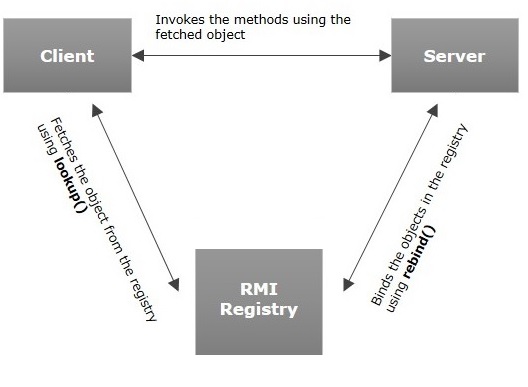
```
Registry(注册表)是放置所有服务器对象的命名空间。
每次服务端创建一个对象时,它都会使用bind()或rebind()方法注册该对象。
这些是使用称为绑定名称的唯一名称注册的。
要调用远程对象,客户端需要该对象的引用,如(HelloRegistryFacade)。
即通过服务端绑定的名称(HelloRegistry)从注册表中获取对象(lookup()方法)。
```
#### (2) 使用Naming方法实现rmi
##### 服务端:
```java
public class NamingService {
public static void main(String[] args) {
try {
// 本地主机上的远程对象注册表Registry的实例
LocateRegistry.createRegistry(1100);
// 创建一个远程对象
HelloNamingFacade hello = new HelloNamingFacadeImpl();
// 把远程对象注册到RMI注册服务器上,并命名为Hello
//绑定的URL标准格式为:rmi://host:port/name
Naming.bind("rmi://localhost:1100/HelloNaming", hello);
System.out.println("======= 启动RMI服务成功! =======");
} catch (RemoteException | MalformedURLException | AlreadyBoundException e) {
e.printStackTrace();
}
}
}
```
接口和接口实现和Registry的方式一样
##### 客户端:
```java
public class NamingClient {
public static void main(String[] args) {
try {
String remoteAddr="rmi://localhost:1100/HelloNaming";
HelloNamingFacade hello = (HelloNamingFacade) Naming.lookup(remoteAddr);
String response = hello.helloWorld("ZhenJin");
System.out.println("=======> " + response + " <=======");
} catch (NotBoundException | RemoteException | MalformedURLException e) {
e.printStackTrace();
}
}
}
```
##### Naming部分源码:
```
public static Remote lookup(String name)
throws NotBoundException,java.net.MalformedURLException,RemoteException{
ParsedNamingURL parsed = parseURL(name);
Registry registry = getRegistry(parsed);
if (parsed.name == null)
return registry;
return registry.lookup(parsed.name);
}
```
Naming其实是对Registry的一个封装
### Scala实现rmi
上面说了rmi是通过JVM虚拟机进行一个远程调用的,我们通过Scala,kotlin等jvm语言印证下
##### 服务端:
```scala
object ScalaRmiService extends App {
try {
val user:UserScalaFacade = new UserScalaFacadeImpl
LocateRegistry.createRegistry(1103)
Naming.rebind("rmi://localhost:1103/UserScala", user)
println("======= 启动RMI服务成功! =======")
} catch {
case e: IOException => println(e)
}
}
```
##### 接口
```
trait UserScalaFacade extends Remote {
/**
* 通过用户名获取用户信息
*/
@throws(classOf[RemoteException])
def getByName(userName: String): User
/**
* 通过用户性别获取用户信息
*/
@throws(classOf[RemoteException])
def getBySex(userSex: String): List[User]
}
```
##### 接口实现:
```
class UserScalaFacadeImpl extends UnicastRemoteObject with UserScalaFacade {
/**
* 模拟一个数据库表
*/
private lazy val userList = List(
new User("Jane", "女", 16),
new User("jack", "男", 17),
new User("ZhenJin", "男", 18)
)
override def getByName(userName: String): User = userList.filter(u => userName.equals(u.userName)).head
override def getBySex(userSex: String): List[User] = userList.filter(u => userSex.equals(u.userSex))
}
```
##### 实体类:
实体类必须实现序列化(Serializable)才能进行一个远程传输
```
class User(name: String, sex: String, age: Int) extends Serializable {
var userName: String = name
var userSex: String = sex
var userAge: Int = age
override def toString = s"User(userName=$userName, userSex=$userSex, userAge=$userAge)"
}
```
##### Scala客户端:
```
object ScalaRmiClient extends App {
try {
val remoteAddr="rmi://localhost:1103/UserScala"
val userFacade = Naming.lookup(remoteAddr).asInstanceOf[UserScalaFacade]
println(userFacade.getByName("ZhenJin"))
System.out.println("--------------------------------------")
for (user <- userFacade.getBySex("男")) println(user)
} catch {
case e: NotBoundException => println(e)
case e: RemoteException => println(e)
case e: MalformedURLException => println(e)
}
}
```
##### Java客户端:
```
public class JavaRmiClient {
public static void main(String[] args) {
try {
String remoteAddr="rmi://localhost:1103/UserScala";
UserScalaFacade userFacade = (UserScalaFacade) Naming.lookup();
User zhenJin = userFacade.getByName("ZhenJin");
System.out.println(zhenJin);
System.out.println("--------------------------------------");
List userList = userFacade.getBySex("男");
System.out.println(userList);
} catch (NotBoundException | RemoteException | MalformedURLException e) {
e.printStackTrace();
}
}
}
```
上面试验可以证明Scala和Java是可以互通的,Scala本身也是可以直接引用Java类的
### 序列化简介
**序列化**([Serialization](https://en.wikipedia.org/wiki/Serialization))是将**数据结构**或对象状态转换为可以存储(例如,在**文件**或存储器[缓冲区中](https://en.wikipedia.org/wiki/Data_buffer))或传输(例如,通过**网络**连接)的格式的过程, **反序列化**(Deserialization)则是从一系列字节中提取数据结构的相反操作.
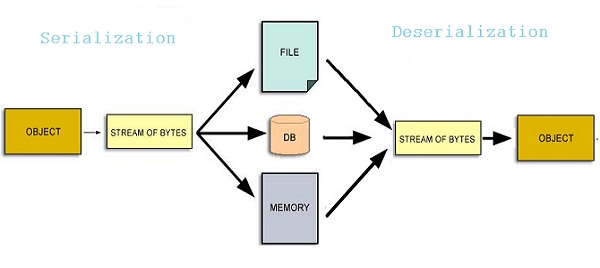
### Kotlin实现rmi
##### 服务端:
```kotlin
fun main(args: Array) {
try {
val hello: HelloKotlinFacade = HelloKotlinFacadeImpl()
LocateRegistry.createRegistry(1102)
Naming.rebind("rmi://localhost:1101/HelloKotlin", hello)
println("======= 启动RMI服务成功! =======")
} catch (e: IOException) {
e.printStackTrace()
}
}
```
##### 客户端:
```kotlin
fun main(args: Array) {
try {
val hello = Naming.lookup("rmi://localhost:1102/HelloKotlin") as HelloKotlinFacade
val response = hello.helloWorld("ZhenJin")
println("=======> $response <=======")
} catch (e: NotBoundException) {
e.printStackTrace()
} catch (e: RemoteException) {
e.printStackTrace()
} catch (e: MalformedURLException) {
e.printStackTrace()
}
}
```
实现和接口省略...
### SpringBoot实现rmi
StringBoot通过配置就可以简单实现rmi了
##### 服务端:
```java
@Configuration
public class RmiServiceConfig {
@Bean
public RmiServiceExporter registerService(UserFacade userFacade) {
RmiServiceExporter rmiServiceExporter = new RmiServiceExporter();
rmiServiceExporter.setServiceName("UserInfo");
rmiServiceExporter.setService(userFacade);
rmiServiceExporter.setServiceInterface(UserFacade.class);
rmiServiceExporter.setRegistryPort(1101);
return rmiServiceExporter;
}
}
```
##### 客户端:
```java
@Configuration
public class RmiClientConfig {
@Bean
public UserFacade userInfo() {
RmiProxyFactoryBean rmiProxyFactoryBean = new RmiProxyFactoryBean();
rmiProxyFactoryBean.setServiceUrl("rmi://localhost:1101/UserInfo");
rmiProxyFactoryBean.setServiceInterface(UserFacade.class);
rmiProxyFactoryBean.afterPropertiesSet();
return (UserFacade) rmiProxyFactoryBean.getObject();
}
}
```
##### 客户端测试类:
```
@Autowired
private UserFacade userFacade;
@Test
public void userBySexTest() {
try {
List userList = userFacade.getBySex("男");
userList.forEach(System.out::println);
} catch (RemoteException e) {
e.printStackTrace();
}
}
```
通过测试类可以看出,这和我们平时的程序调用内部方法没什么区别!
### rmi调用过程
大家可以通过下面文章加深了解:
https://stuff.mit.edu/afs/athena/software/java/java_v1.2.2/distrib/sun4x_56/docs/guide/rmi/Factory.html
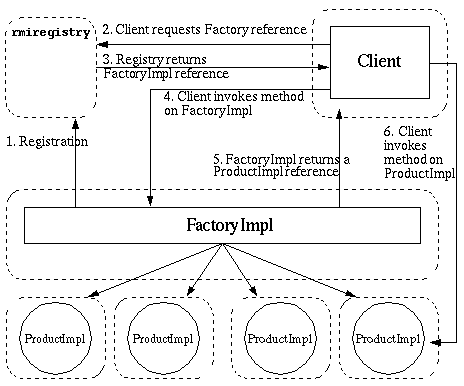
- 有两个远程服务接口可供client调用,Factory和Product接口
- FactoryImpl类实现了Factory接口,ProductImpl类实现了Product接口
```
1. FactoryImpl被注册到了rmi-registry中
2. client端请求一个Factory的引用
3. rmi-registry返回client端一个FactoryImpl的引用
4. client端调用FactoryImpl的远程方法请求一个ProductImpl的远程引用
5. FactoryImpl返回给client端一个ProductImpl引用
6. client通过ProductImpl引用调用远程方法
```
### Zookeeper实现rmi
#### 安装Zookeeper
解压 ZooKeeper
```
tar -zxvf zookeeper-3.4.12.tar.gz
```
在 conf 目录新建 zoo.cfg
```
cd zookeeper-3.4.12/conf
vim zoo.cfg
```
zoo.cfg 代码如下(自己指定 log 文件目录):
```
tickTime=2000
dataDir=/usr/local/zookeeper-3.4.12/data
dataLogDir=/usr/local/zookeeper-3.4.12/log
clientPort=2181
```
在 bin 目录下,启动 Zookeeper:
```
cd zookeeper-3.4.12/bin
./zkServer.sh start
```
#### 消费者:
出处:`http://www.importnew.com/20344.html`
```
public class RmiConsumer {
// 用于等待 SyncConnected 事件触发后继续执行当前线程
private CountDownLatch latch = new CountDownLatch(1);
// 定义一个 volatile 成员变量,用于保存最新的 RMI 地址(考虑到该变量或许会被其它线程所修改,一旦修改后,该变量的值会影响到所有线程)
private volatile List urlList = new ArrayList<>();
// 构造器
public RmiConsumer() {
ZooKeeper zk = connectServer(); // 连接 ZooKeeper 服务器并获取 ZooKeeper 对象
if (zk != null) {
watchNode(zk); // 观察 /registry 节点的所有子节点并更新 urlList 成员变量
}
}
// 查找 RMI 服务
public T lookup() {
T service = null;
int size = urlList.size();
if (size > 0) {
String url;
if (size == 1) {
url = urlList.get(0); // 若 urlList 中只有一个元素,则直接获取该元素
log.debug("using only url: {}", url);
} else {
url = urlList.get(ThreadLocalRandom.current().nextInt(size)); // 若 urlList 中存在多个元素,则随机获取一个元素
log.debug("using random url: {}", url);
}
service = lookupService(url); // 从 JNDI 中查找 RMI 服务
}
return service;
}
// 连接 ZooKeeper 服务器
private ZooKeeper connectServer() {
ZooKeeper zk = null;
try {
zk = new ZooKeeper(Constant.ZK_CONNECTION_STRING, Constant.ZK_SESSION_TIMEOUT, new Watcher() {
@Override
public void process(WatchedEvent event) {
if (event.getState() == Event.KeeperState.SyncConnected) {
latch.countDown(); // 唤醒当前正在执行的线程
}
}
});
latch.await(); // 使当前线程处于等待状态
} catch (IOException | InterruptedException e) {
log.error("", e);
}
return zk;
}
// 观察 /registry 节点下所有子节点是否有变化
private void watchNode(final ZooKeeper zk) {
try {
List nodeList = zk.getChildren(Constant.ZK_REGISTRY_PATH, event -> {
if (event.getType() == Watcher.Event.EventType.NodeChildrenChanged) {
watchNode(zk); // 若子节点有变化,则重新调用该方法(为了获取最新子节点中的数据)
}
});
List dataList = new ArrayList<>(); // 用于存放 /registry 所有子节点中的数据
for (String node : nodeList) {
byte[] data = zk.getData(Constant.ZK_REGISTRY_PATH + "/" + node, false, null); // 获取 /registry 的子节点中的数据
dataList.add(new String(data));
}
log.debug("node data: {}", dataList);
urlList = dataList; // 更新最新的 RMI 地址
} catch (KeeperException | InterruptedException e) {
log.error("", e);
}
}
// 在 JNDI 中查找 RMI 远程服务对象
@SuppressWarnings("unchecked")
private T lookupService(String url) {
T remote = null;
try {
remote = (T) Naming.lookup(url);
} catch (NotBoundException | MalformedURLException | RemoteException e) {
log.error("远程查找出错!", e);
}
return remote;
}
}
```
#### 生产者:
```
public class RmiProvider {
/**
* 用于等待 SyncConnected 事件触发后继续执行当前线程
*/
private CountDownLatch latch = new CountDownLatch(1);
// 发布 RMI 服务并注册 RMI 地址到 ZooKeeper 中
public void publish(Remote remote, String host, int port) {
String url = publishService(remote, host, port); // 发布 RMI 服务并返回 RMI 地址
if (url != null) {
ZooKeeper zk = connectServer(); // 连接 ZooKeeper 服务器并获取 ZooKeeper 对象
if (zk != null) {
createNode(zk, url); // 创建 ZNode 并将 RMI 地址放入 ZNode 上
}
}
}
/**
*发布 RMI 服务
*/
private String publishService(Remote remote, String host, int port) {
String url = null;
try {
url = String.format("rmi://%s:%d/%s", host, port, remote.getClass().getName());
LocateRegistry.createRegistry(port);
Naming.rebind(url, remote);
log.debug("publish rmi service (url: {})", url);
} catch (RemoteException | MalformedURLException e) {
log.error("", e);
}
return url;
}
// 连接 ZooKeeper 服务器
private ZooKeeper connectServer() {
ZooKeeper zk = null;
try {
zk = new ZooKeeper(Constant.ZK_CONNECTION_STRING, Constant.ZK_SESSION_TIMEOUT, new Watcher() {
@Override
public void process(WatchedEvent event) {
if (event.getState() == Event.KeeperState.SyncConnected) {
latch.countDown(); // 唤醒当前正在执行的线程
}
}
});
latch.await(); // 使当前线程处于等待状态
} catch (IOException | InterruptedException e) {
log.error("", e);
}
return zk;
}
/**
* 创建节点
*/
private void createNode(ZooKeeper zk, String url) {
try {
byte[] data = url.getBytes();
String path = zk.create(Constant.ZK_PROVIDER_PATH, data, ZooDefs.Ids.OPEN_ACL_UNSAFE, CreateMode.EPHEMERAL_SEQUENTIAL); // 创建一个临时性且有序的 ZNode
log.debug("create zookeeper node ({} => {})", path, url);
} catch (KeeperException | InterruptedException e) {
log.error("", e);
}
}
}
```
#### 图解:
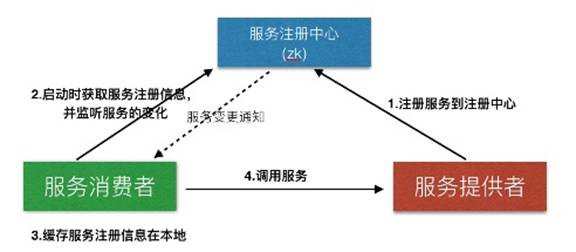
代码已上传到GitHub上:https://github.com/jayknoxqu/rmi-example